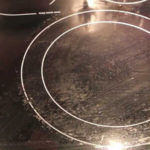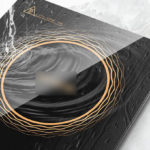As many home cooks know, glass cookware is a favorite for its elegant design, food-safe materials, and heat resistance. However, using glass cookware on an induction cooktop requires some tricks. While glass cookware is not compatible with induction cooktops due to its non-ferromagnetic properties, there are workarounds to indirectly utilize it on such stoves.
Principle
Induction cooktops operate based on the principle of magnetic induction, requiring cookware with ferromagnetic properties to function. Glass, being non-ferromagnetic, won’t work directly on an induction cooktop as it won’t respond to the magnetic field generated by the cooktop.
Tips for Using Glass Cookware on an Induction Stove
While direct use is not possible, there’s a simple solution to indirectly use glass cookware on an induction cooktop.
 Use a ferromagnetic disc to enable cooking with a glass pot on an induction stove.
Use a ferromagnetic disc to enable cooking with a glass pot on an induction stove.
Ferromagnetic Disc
Place a ferromagnetic disc, made of stainless steel (such as 304 or 430-grade stainless steel), between the glass pot and the induction cooktop. This disc will absorb the magnetic field and transfer the heat to the glass pot, allowing you to cook as usual. Simply place the disc on the cooking zone, put your glass pot on top, and turn on the cooktop.
This disc is versatile and can also be used with aluminum, ceramic, and clay pots.
After cooking, wait for about a minute to let the disc cool down before removing and cleaning it. Avoid using corrosive cleaning agents or sharp tools to prevent damage to the disc.
Alternatively, you can find glass cookware with ferromagnetic bases. These pots have a layer of ferromagnetic material at the base, allowing them to work on induction cooktops.
Combination Induction and Electric Cooktop
Another option is to opt for a combination induction and electric cooktop, which offers the best of both worlds. One side of the cooktop uses infrared heating, suitable for non-ferromagnetic cookware like glass, aluminum, or clay pots, while the other side is an induction cooktop for ferromagnetic cookware. This setup provides a comprehensive solution for those transitioning from gas stoves to induction or infrared cooking, allowing you to continue using your existing cookware.
 Using a glass pot with a ferromagnetic base directly on an induction cooktop.
Using a glass pot with a ferromagnetic base directly on an induction cooktop.
Notes on Using Ferromagnetic Discs with Induction Cooktops
– Choose a disc that matches the size of your pot to ensure even heating and efficient cooking, preventing heat loss and energy wastage.
– Ensure the disc has good friction with the pot’s base to prevent slipping during cooking, maintaining a safe cooking experience.
– Keep the base of your glass pot flat to maximize contact area and heat transfer efficiency, resulting in faster cooking and energy savings.
– Check that the disc is flat and not warped, as this could reduce heat transfer efficiency and potentially affect safety.
Advantages and Disadvantages of Using Glass Cookware on an Induction Stove
Advantages
– Health and safety: Glass cookware is made from high-quality borosilicate glass, free from BPA and other harmful substances, ensuring a safe cooking experience.
– High heat resistance: Glass cookware can withstand temperatures up to 400-800°C, making it suitable for various cooking methods, including induction, gas, oven, and microwave cooking.
– Easy observation: The transparent glass lid allows you to monitor the cooking process without lifting the lid, preventing heat loss.
– Easy to clean: The smooth surface of glass cookware prevents food from sticking, making cleanup a breeze.
– Aesthetic appeal: Glass cookware adds a touch of elegance to your kitchen with its modern and sleek design.
Disadvantages
– Fragility: Glass cookware is more fragile than metal cookware, requiring careful handling to prevent breakage.
– Slower cooking: Glass cookware conducts heat less efficiently than metal cookware, resulting in slightly longer cooking times.
– Higher cost: Glass cookware tends to be more expensive than metal alternatives.
– Requires a ferromagnetic disc: To use glass cookware on an induction stove, you need to invest in a ferromagnetic disc or choose glass cookware with a ferromagnetic base.
According to GĐXHp>
The Ultimate Guide to Removing Stubborn Stains from Your Electric Stove: A Surprising Hack
Introducing the Ultimate Guide to Stain Removal on Electric Stoves: Uncover the Secret to Sparkling Surfaces with Just One Surprising Tool!
Stay tuned to discover the ingenious method that will revolutionize the way you clean your electric stove, erasing those stubborn stains for good. This game-changing technique will be your new go-to, ensuring a spotless and sparkling stove top that’s sure to impress.
Should You Unplug Your Induction Cooktop After Use?
 Induction Cooktop After Use?’>
Induction Cooktop After Use?’>“Induction cooktops are the latest in electric cooking technology, offering a convenient, efficient, and modern alternative to traditional cooking methods. With their sleek designs and powerful performance, induction cooktops are a popular choice for those seeking a stylish and cost-effective way to prepare meals. This innovative cooking technology is taking the market by storm, and it’s easy to see why.”


































